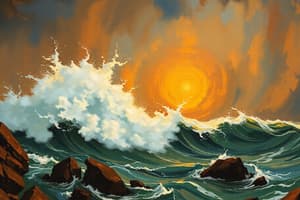Podcast
Questions and Answers
What factors determine whether an earthquake will trigger a tsunami?
What factors determine whether an earthquake will trigger a tsunami?
- Magnitude and location along plate boundaries (correct)
- Depth of the earthquake and its duration
- Type of seismic waves produced and the time of day
- Distance from the earthquake epicenter and the Richter scale value
Which seismic waves play essential roles in generating tsunamis?
Which seismic waves play essential roles in generating tsunamis?
- P-waves and S-waves
- P-waves and L-waves
- Surface waves and P-waves
- S-waves and surface waves (correct)
What do Love waves do during an earthquake?
What do Love waves do during an earthquake?
- Propagate faster than P-waves
- Cause compression motion in the ground
- Move vertically along fault lines
- Radiate sideways from the epicenter (correct)
Which instruments are used in tsunami warning systems for early detection?
Which instruments are used in tsunami warning systems for early detection?
What principle remains constant throughout any earthquake or tsunami process?
What principle remains constant throughout any earthquake or tsunami process?
What role do larger magnitude earthquakes play in generating tsunamis?
What role do larger magnitude earthquakes play in generating tsunamis?
What causes an earthquake?
What causes an earthquake?
What type of waves are commonly associated with earthquakes?
What type of waves are commonly associated with earthquakes?
How do tsunamis originate?
How do tsunamis originate?
What happens when part of the ocean floor displaces vertically due to an undersea earthquake?
What happens when part of the ocean floor displaces vertically due to an undersea earthquake?
Which principle explains the release of elastic strain energy during an earthquake?
Which principle explains the release of elastic strain energy during an earthquake?
How do tsunami waves grow in height after being generated?
How do tsunami waves grow in height after being generated?
Flashcards are hidden until you start studying
Study Notes
Earthquakes and Tsunamis: Understanding Their Connections
Earthquakes and tsunamis are two natural phenomena often intertwined due to their shared origins. Let's unpack these processes step by step, starting with earthquakes and how they can lead to one of nature's most destructive forces - tsunamis.
Earthquake Causes
An earthquake occurs when tectonic plates beneath our planet's surface move against each other or slide past one another. Friction between these massive slabs makes them "stick," but eventually, this force triggers sudden movement, creating the ground shaking we feel during an earthquake.
The rupture between plates is called a fault, which releases elastic strain stored within the earth's crust as kinetic energy. This released energy radiates outward from its source in the form of seismic waves, namely P-waves (pressure) and S-waves (shear). These wave types travel through the earth's interior and influence tsunami generation.
Tsunami Formation
Tsunamis originate from large-scale disturbances in water depth caused by undersea earthquakes or volcanic eruptions. When part of the ocean floor suddenly displaces vertically (either upwards or downwards), it creates a ripple effect across the surrounding water basin. Although the initial vertical displacement may only amount to centimeters, the resulting waves grow exponentially in height after traveling vast distances over open water.
Two primary factors determine whether an earthquake will trigger a tsunami: magnitude and location along plate boundaries. Larger magnitude events typically generate more significant vertical movements, while shallow earthquakes near land or coastal areas have higher potential as tsunami sources.
Seismic Waves
As mentioned earlier, earthquakes produce three main kinds of seismic waves: P-, S-, and surface waves (L-waves). P-waves are faster because they oscillate primarily in compression, while S-waves propagate slower due to shearing motion. On the other hand, surface waves (also known as Love and Rayleigh waves) interact directly with the Earth's surface and cause the most noticeable effects felt during an earthquake.
Both S-waves and surface waves play essential roles in generating tsunamis. Submarine landslides driven by strong S-waves can displace large volumes of water, causing localized tsunamis. Additionally, Love waves tend to radiate sideways from the epicenter, generating transverse motions in the sea floor capable of producing drawback and uplift cycles in the water column, further contributing to tsunami genesis.
Tsunami Warning Systems
Governments worldwide continuously monitor global seismicity via networks of specialized instruments such as seismographs, tide gauges, and deep-ocean pressure sensors. Early detection and evaluation of various parameters allow scientists to issue warnings before devastating waves reach populated regions like coastlines.
Modern technology also enables real-time data processing and dissemination to reduce response times during emergent situations. Once an event is confirmed as potentially hazardous, authorities sound alerts throughout affected communities to help ensure timely evacuations and safety precautions.
Law of Conservation of Energy
Throughout any given earthquake or tsunami process, the law of conservation of energy remains constant. Earthquakes release energy accumulating in tectonic stresses, transforming into mechanical work and heat dissipation at the site and nearby areas. Similarly, tsunami-generating earthquakes transfer kinetic energy derived from the slippage between adjacent tectonic plates to displaced water masses. In both cases, the total quantity of energy remains conserved; however, it may change forms or be transferred from one system to another.
In conclusion, understanding the connections among earthquakes, tsunamis, seismic waves, and the principles governing energy transfer provides valuable insights into predictability and mitigation efforts. By studying these phenomena, researchers and policymakers aim to develop advanced tools and strategies to safeguard lives and property threatened by natural catastrophes.
Studying That Suits You
Use AI to generate personalized quizzes and flashcards to suit your learning preferences.





